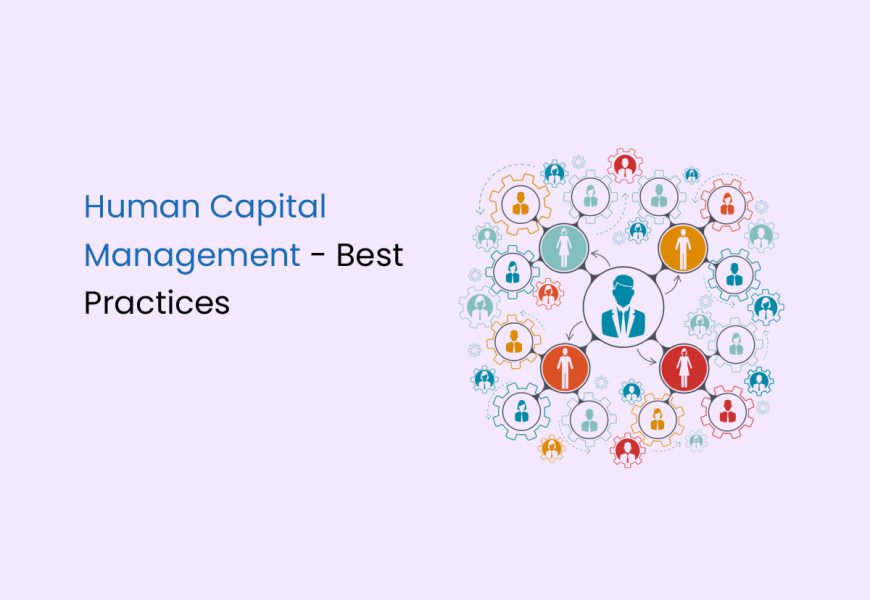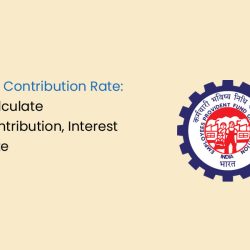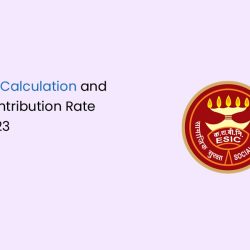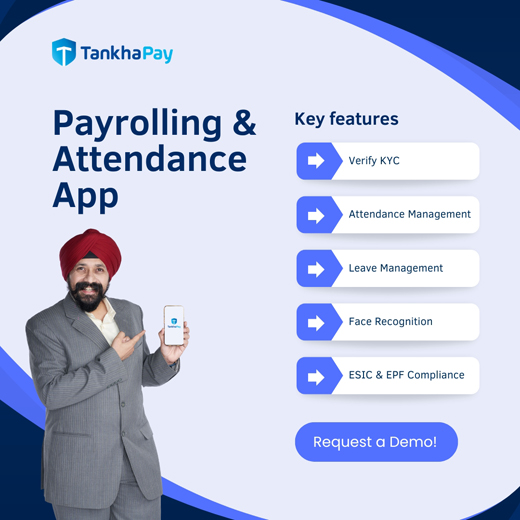Organisations today understand that their workforce is their greatest asset, and success is no longer only about products or services but also about people. As a result, Human Capital Management (HCM) has become a driving force behind many new business practices, a growing abundance of HCM software solutions, and an emphasis on human capital as a competitive advantage.
Let’s discuss what HCM is and why it’s important.
What is the Full Form of HCM?
The full form of HCM is Human Capital Management. HCM is a system that transforms the traditional administrative functions of HR, such as recruiting, training, payroll, compensation, and performance management, into opportunities to drive engagement, productivity, and business value. HCM views the workforce as a core business asset that, just like any other asset, can be maximised through strategic investment and management.
Components of Human Capital Management (HCM)
The components of HCM are as follows:
- Talent Management: Organisations nurture employees throughout their employment, including sourcing, recruiting, onboarding, performance management, rewarding, learning, career development, talent reviews, and succession planning, to keep them engaged.
- Recruitment and Hiring: It provides the tools HR needs to attract and hire talent to help the organisation achieve its goals by positioning it as an ideal workplace.
- Onboarding and Training: Managing human capital involves effectively onboarding new employees. This process introduces them to the company culture, job requirements, and expectations, creating an environment that helps them fit into their roles. Another crucial aspect of HCM is training employees to perform their best for the organisation.
- Benefits Administration: It can help simplify managing workforce benefits for employees. They only need to set up benefit plans once to drive enrollment and deductions throughout the system.
- Time, Attendance and Payroll: HCM makes it easier to track and manage employees’ on-the-job hours and automate payroll.
- Employee Self-Service: HCM offers self-service applications for leave and security requirements, HR help desks and keeps track of payroll and benefits.
- Reporting and Analytics: It provides a database of actionable insights to add value to employees. This database includes data from performance reviews, employee benefits claims, skills, turnover rate, and other statistics. By analysing this information, organisations can adjust their practices and improve the work environment to meet their objectives.
Benefits of Human Capital Management (HCM)
HCM can benefit an organisation in the following ways:
- Hires the People Most Suited for the Role: HCM processes identify employee competencies and match them to suitable positions.
- Increases Workforce Productivity and Efficiency: Organisations should invest in specific capabilities, training and development to boost productivity. HCM enhances efficiency by placing employees in roles suited to their strengths.
- Streamlines HR Functions: HCM streamlines HR processes by consolidating systems, leveraging analytics for better decisions, and automating manual tasks.
- Reduces costs and Increases ROI: An effective human resource management system can simplify processes, reduce costs, increase revenue, and improve ROI.
- Strengthens Employee Development and Career Planning: Human capital management involves identifying capability gaps through training, surveys, performance reviews, and other feedback sources. It helps to provide adequate training to employees, enabling them to deliver their best performance.
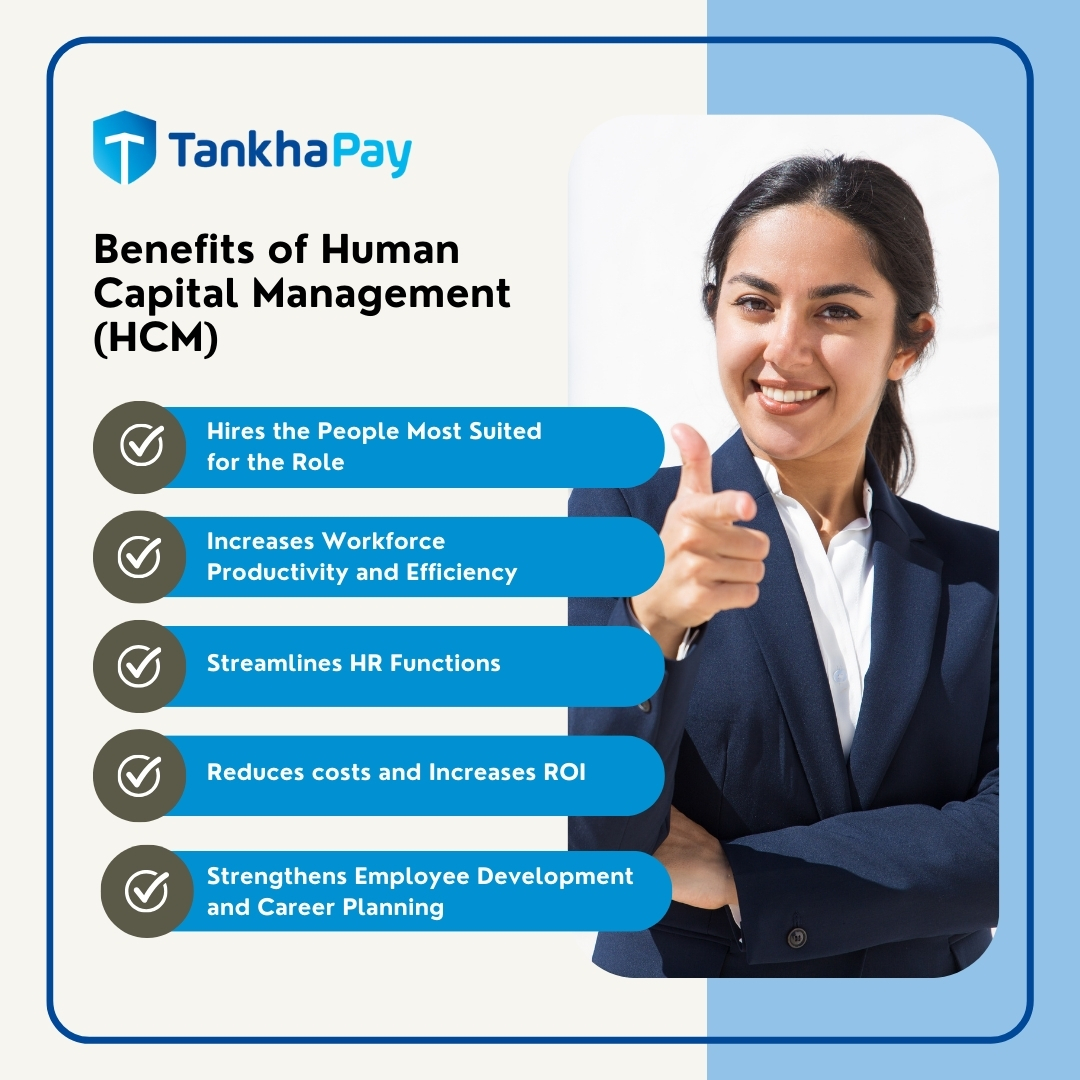
What Is A Human Capital Management System?
A human capital management system refers to the set of business practices, HR processes, and technologies that enable an organisation to acquire, manage, and develop human capital in an organised manner and on a large scale. Such a system takes a broad, organisation-wide view of human capital and helps manage it in a structured way.
Elements of A Human Capital Management (HCM) System
The elements required for a human capital management system are as follows:
- Organisational vision and values
Defining a company’s vision and values is integral to shaping its culture and recognising the importance of human capital. - Strategic Goals and Objectives
Human capital initiatives should be driven by the organisation’s specific, measurable, time-bound objectives like quarterly or annual goals. - HCM leadership team
Human capital initiatives have a far-reaching impact on organisations. HCM teams are usually cross-functional, consisting of leaders from different departments. In companies with an HR department, the topmost HR leader, such as the Chief Human Resource Officer or the VP of HR, would typically drive HCM initiatives. In smaller organisations, this responsibility would fall on a senior executive like the CEO or COO. - Data management and support
It’s essential to have access to employee-related data to manage and measure the results of human capital initiatives effectively. This data can be captured, stored, and analysed through workforce analytics. Employee-related data that can be tracked include demographics, compensation and benefits, payroll, time and attendance, performance management, and skills training and development. A human capital management system can be implemented to streamline these processes regardless of the company’s size.
Advantages and Disadvantages of a Human Capital Management (HCM) System
HCM offers significant advantages for managing workforce processes but also presents challenges.
Advantages
- It automates a variety of HR tasks, improving efficiency and accuracy.
- HCM provides valuable insights through analytics, aiding in strategic decision-making.
- It helps improve processes like onboarding and training, boosting employee satisfaction.
- HCM ensures compliance with labour laws and regulations, reducing legal risks.
- It aids in recruitment, performance management, and employee retention.
Disadvantages
- Initial setup and maintenance of HCM systems can be costly.
- The integration of HCM with existing systems can be complex and time-consuming.
- HCM can require staff training and may face resistance to change from employees.
- The management and protection of sensitive employee data can pose a significant challenge.
- Its reliance on technology can be problematic in case there is a system failure or power outage.
Human Capital Management (HCM) Software
Human Capital Management (HCM) software is a technology application designed to help employers manage and nurture their employees. It is sometimes called an Human Resources Information System (HRIS) or Human Resources Management System (HRMS). The software can combine talent planning, management, and analytics into a single system that deals with company-wide HR processes to increase human capital ROI.
An Human Resources Information System (HRIS) focuses on data and processes for individual staff members. In contrast, an HRMS provides a comprehensive suite of HR software features. This suite includes a complete HRIS, HCM capabilities, time management, and payroll. It allows the integration of all HR and HCM processes in the HRMS.
Benefits of Human Capital Management (HCM) Software
The benefits of an HCM software are as follows:
- Integrated Systems for HR Functions: The right software can help businesses improve efficiency, simplify tasks, reduce errors, offer easy HR access, and enhance employee benefits.
- Data-Driven Decision-Making: HCM software integrates functions for real-time data access, analysis, and decision-making using cloud technology.
- Improves Compliance: HCM software automates the workflows, checklists, reporting, filing and documentation required to help businesses remain compliant.
- Data Security and Privacy: These systems have tight security protocols with access rights carefully customised to an organisation’s needs.
- Enhanced Reporting: By implementing an all-in-one solution, an organisation can easily monitor employee data and generate actionable reports in various file formats.
How to Choose a Human Capital Management (HCM) System
You can choose an Human Capital Management (HCM) system by following these steps:
- To determine the most suitable HCM system for your organisation, creating a checklist of requirements defining the business objectives that rely on HCM is essential. This checklist should also highlight how not achieving these goals will impact your organisation.
- To ensure the successful implementation of HCM solutions, create a detailed action plan, including the project scope, necessary resources, budget, and team leaders.
- It is crucial to identify the internal stakeholders most affected by this project and keep them informed at all times.
- Familiarising yourself with the organisation’s approval process for transformative projects and outsourced solutions is essential.
- To gain approval from stakeholders, it’s vital to present the solution and showcase the business, financial and end-user benefits. You can use an HCM business case template to make your point effectively.
Future of Human Capital Management (HCM)
Technology is rapidly changing the work world, leading to the elimination of some job roles and the creation of new work opportunities. The traditional hierarchical structures are giving way to flatter, more agile networks of teams that are becoming more mobile, global, and diverse. Human Capital Management (HCM) is also evolving rapidly. We can expect to see the increasing adoption of technologies like Software as a Service (SaaS) and mobile, as well as cutting-edge technologies like machine learning and AI. Some examples are:
- Mobile technology empowers HR, workers, and managers with consumer-grade, self-service mobile apps to increase engagement and productivity.
- Collaborations with peers and mentors in the organisation help improve productivity for everyone and enhance social skills.
- Chatbots can serve constituents more efficiently with accurate answers and faster response times.
- AI can augment what is not humanly possible, for example, quickly mining through thousands of resumes and data points to find the most suitable candidates.
Conclusion
Investing in people is more than just a business strategy; it’s a philosophy that drives companies towards greatness. When companies value and invest in their human capital, they create a workplace where employees can thrive, innovation can flourish, and success becomes a natural outcome. After all, people are not just the driving force behind achieving success. They are the foundation on which it is built. Human capital management is critical to the success of any organisation.
Frequently Asked Questions
What is the difference between HR and HCM?
HRM focuses on traditional HR functions like recruitment, payroll and compliance. At the same time, HCM takes a more strategic approach, integrating HR functions with overall business strategy. HCM encompasses talent management, workforce planning, performance management and employee development.
What are the three kinds of human capital?
Human capital refers to an individual's collective skills, knowledge, and abilities in a particular group or society. These skills, knowledge, and abilities can be classified into three main types: knowledge capital, social capital, and emotional capital.
How can you build human capital?
Building human capital requires investing in your workforce. You can do this by hiring and retaining top talent, regular performance monitoring and ongoing training, and offering competitive pay and incentives, which can also aid retention.
Does HCM include payroll?
Most fully integrated HCM solutions automate payroll and accommodate flexible pay options, such as early access to wages, pay cards, and pay frequency.
What are the functions of HCM?
HCM covers fundamental HR functions such as payroll, time and attendance, benefits administration, and workforce management elements such as employee training, engagement and retention, and compliance.
What are the objectives of HCM?
HCM aims to support growth, empower employees and connect people and workflows. Some solutions offer personalised experiences based on function, location, team, and individual.

